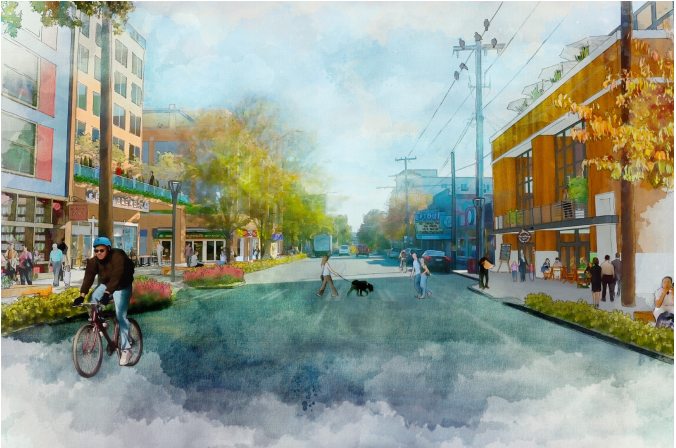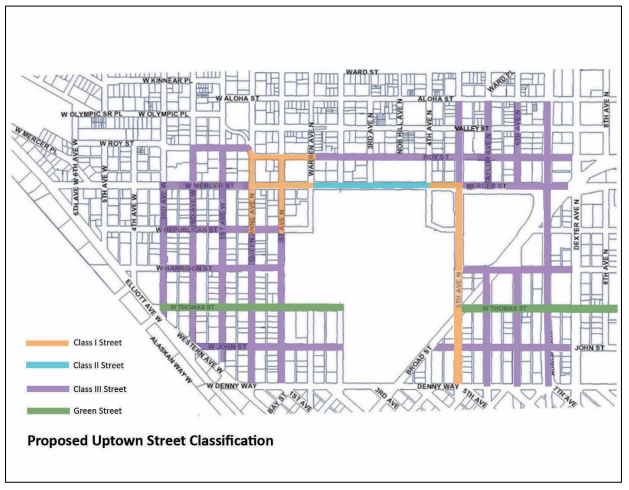Last month, I provided a high-level overview of the Final Environmental Impact Statement (EIS) for land use changes in the Uptown neighborhood. To realize the modeled land use changes in the Final EIS, the Office of Planning and Community Development (OPCD) has drafted specific development regulations that would be paired with zoning changes. These include custom-made urban design regulations for the Seattle Mixed-Uptown (SM-UP) zones that touch on things like:
- Street-level uses, street-level facade requirements, and enhanced parking standards;
- Maximum and minimum development density;
- Maximum building width, facade modulation, and maximum blank facade standards;
- Incentive zoning for childcare facilities, streetscape improvements, open space, and historic preservation; and
- Podium site coverage and height, tower floorplate maximums, and number of towers allowed.
More broadly, the rezones and new development regulations would be subject to mandatory affordability housing requirements. Zones that do not change to the SM-UP zoning type would have to meet the existing development standards.
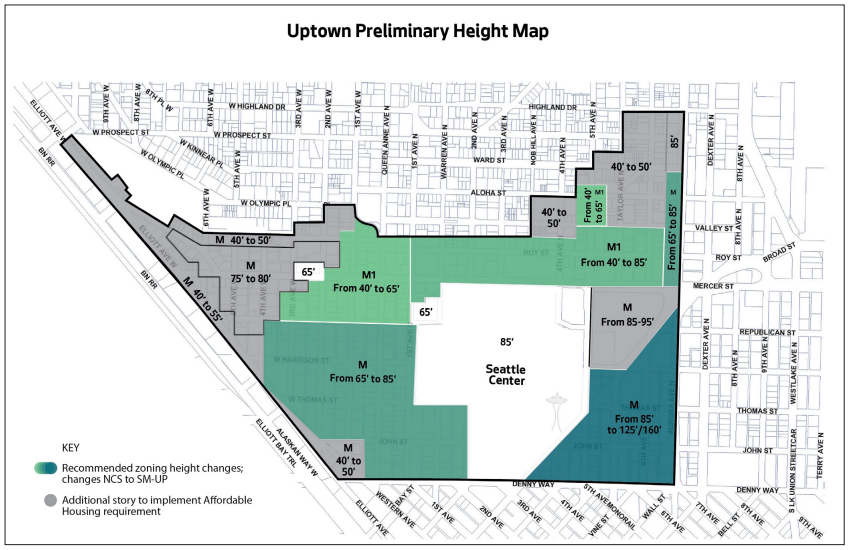
Pedestrian Street Classifications
New pedestrian street classifications are proposed for Uptown, which would be codified in the development regulations for the use of pedestrian-oriented urban design requirements. The map below indicates the differing street classifications proposed and the table following it highlight the types of standards would apply based upon the abutting street classification of a site with SM-UP zoning.
| Standard | Class I Street | Class II Street | Class III Street | Neighborhood Green Street |
|---|---|---|---|---|
| Street Level Uses* | 75% of street frontage must consist of street-level uses. Street-level uses must be within 10 feet of street lot line or open space abutting the street. Floor to ceiling clearance shall be a minimum of 13 feet and be 30 feet in depth. | 30% of street frontage must consist of street-level uses. Street-level uses must be within 10 feet of street lot line or open space abutting the street. Floor to ceiling clearance shall be a minimum of 13 feet and be 30 feet in depth. | No requirements, but street-level uses are exempt from floor area ratio limits if they meet standards set out for Class I streets. | No requirements, but street-level uses are exempt from floor area ratio limits if they meet standards set out for Class I streets. |
| Street Level Facades | 70% of street frontage must consist of street-level facades and directly abut the street. | 70% of street frontage must consist of street-level facades and may be set back from the street. Generally, the maximum setback allowed is 12 feet, but 30% of the street-level facade may be setback 20 feet and additional setbacks may be allowed if behind an open space. | ||
| Minimum FAR | Must meet minimum floor area for zone. | |||
| Primary Pedestrian Entrance | New structures facing the designated street are required to provide a primary building entrance for pedestrians from the street or a street-oriented courtyard that is no more than three feet above or below the sidewalk grade. | N/A | ||
| Transparency** | 60% of facade must be transparent. | |||
| Upper-Level Setbacks | For structures 45 feet or greater in height, one foot for every two feet in height to a maximum of 15 feet. | N/A | ||
| Parking | Parking is prohibited as a principal use. No more than 50% of parking above grade. Ground-level parking shall be separated from right-of-way by another use. Upper-level parking shall be completely screened. | |||
| Minimum Facade Height Requirements | 45 feet high. | 25 feet high. | 15 feet high. | |
| Blank Facade Maximum | The maximum width of blank facades is 15 feet (exceptions permitted for garage doors). Total frontage of blank facades cannot exceed 30% of the facade frontage. | |||
| Open Space*** | For projects on sites that are 30,000 square feet or greater, usable ground-level open space equivalent to 15% of site area is required. | |||
| Mid-Block Connection | Required for projects on sites of 40,000 square feet or greater. Connection is required to average 25 feet in width with a minimum of 15 feet. No more than 35% of the length of the connection shall be covered or enclosed. | |||
| Notes: *Retail, restaurants, and entertainment uses, public libraries, public parks, and arts facilities. **Transparency requirements apply to all street-facing street-level facades excluding ground-level residential development. ***Additional open space are required for large office developments. | ||||
Minimum Density
Depending upon the ultimate zoning put in place, new developments on many sites with SM-UP zoning would need to meet the following minimum density regulations, which are similar to the ones already in force on properties with a Pedestrian designation. The implications of the regulation, however, would be far more reaching since proposed Class I, Class II, and Class III Pedestrian Streets and Neighborhood Green Streets would cover most streets receiving a rezone. The minimum density regulations are designed to prevent under-building on sites and encourage pedestrian-oriented developments.
It’s worth noting, too, that minimum density requirements would apply to any development action that proposes to add or remove more than 1,000 square feet of gross floor area. So minor changes could be exempt even if they fall on properties meeting the street classification standard and zoning, but they would be a rare exception.

Maximum Density
On the flipside of density control, the draft regulations would new establish maximum density requirements for the custom made SM-UP zones. Each zoning type would be paired with a base floor area ratio (FAR) maximum regardless of use. In the SM-UP 125 and SM-UP 160 zones, the maximum FAR could be increased above the base if certain incentives are used to achieve the additional floor area. In other cases, the base FAR limit is the absolute maximum, so in the SM-UP 65 zone, a developer could proposed a 4.5 FAR of exclusively residential uses, but would then be unable to include any non-residential uses. In the SM-UP 160 zone, non-residential uses are limited to encourage residential high-rises.
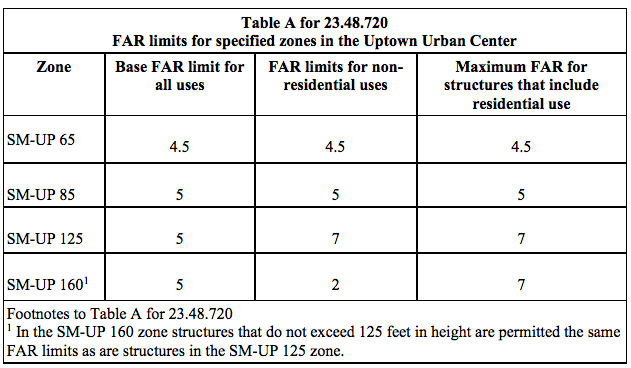
Incentive Zoning
In the SM-UP zones, incentive zoning would be required to construct floor area in buildings above 95 feet in height or to achieve any floor area ratio greater than 5.0. Any development seeking to use incentive zoning would need to constructed to LEED Gold standards, prepare an acceptable Transportation Management Plan, and meet the following requirements:
- For extra residential floor area, at least 65% of the additional floor area would need to be achieved by providing affordable housing.
- For extra non-residential floor area, at least 65% of the floor area would be need to be achieved by providing childcare facilities and/or affordable housing. The amount of credited space for each slot in a childcare facility would be equal to 8,000 square feet of extra floor area.
- The remaining 35% of the extra floor area would need to be achieved by acquiring open space, providing a Green Street setback, making Green Street improvements, creating a mid-block corridor on a Green Street, or using transfer of development rights (TDR) from historic structures, vulnerable masonry structures, and open space in the neighborhood.
Maximum Building Width
Generally, buildings in SM-UP zones wouldn’t be permitted to exceed a width or depth of 250 feet. The development standard, however, wouldn’t apply to retained Landmark structures that are redeveloped nor to structures that have more 50% of the total gross floor area dedicated to uses such as: community clubs or community centers, religious institutions, performing arts facilities, or early education (e.g. preschool, elementary, or secondary schools). A special exception would also be carved out a low-rise structure containing a light rail station. The overall goal of the general requirement is to reduce structural bulk and foster variety of buildings on streets.
Motorized Vehicle Parking
Additional parking standards for motorized vehicles are proposed for all SM-UP zones with a goal of providing a better urban design experience for pedestrians. Generally, one story of parking above the first story of a building would be permitted for each story of parking below ground, up to a maximum of two stories above ground. At street level, parking areas would only be permitted if they are fully separated from the street by another use in a structure. And for parking areas above the first story, the following requirements would have to be met:
- Generally, at least 30% of the length along a street would need to be separated by another use;
- In case the case of parking areas located at an intersection, the parking area would need to be separated by another use at the corner; and
- Any area not separated by another use would need to be fully enclosed along all street frontages to hide the parking.
Transfer of Development Rights
Properties with an SM-UP, LR1, LR2, or MR zoning designation in Uptown may qualify as a sending site for the purposes of transfer of development rights (TDR). This means that such properties may send some or all of their qualifying development capacity to other properties (receiving sites) in Uptown that are eligible to use TDR credits for additional development capacity. A qualifying sending site must consist of an architecturally historic structure, vulnerable masonry building, or a qualifying open space set-aside.
There are specific conditions on determining the eligibility of historic structures to convert existing square footage into TDR credits that may be sold or transferred:
- The structure must be retained for at least 50 years;
- The structure must be fully rehabilitated to applicable code standards;
- Exterior facades must generally be retained; and
- Additions and alterations may only be permitted if they will help extend the useful life or economic viability of the structure.
Meanwhile, a vulnerable masonry structure may be eligible to convert existing square footage into TDR credits that may be sold or transferred if the structure will be reinforced and enhanced in such a way that its useful life will be extended by at least 50 years.
Property owners of eligible sending sites may convert their unused or sold development allowances into TDRs credits, which are equal to the total residential and non-residential floor area under the maximum base floor area ratio for the zone.
Open Space Requirement For Office Space
New open space requirements would be added for office space development in SM-UP zones with a height limit that exceeds 85 feet. The general requirement would apply to all development proposals with more than 85,000 square feet of office space. The open space requirement would be a ratio of 20 square feet for every 1,000 square feet of gross office floor area. Open space that is developed under the provisions could be provided on-site or off-site; alternatively, a developer could make an in-lieu fee payment for open space to the City.
- If a developer chose to develop open space on-site, the space would need to have a minimum dimension of 20 feet in width and length and have a 13-foot height clearance to qualify. The space would also need to be publicly accessible from the street or abutting open space and remain open during business hours. Additionally, developers could use the open space as credit for bonus floor area.
- If a developer chose to acquire and develop open space off-site, the space would need to be a minimum of 3,000 square feet and located in a nearby SM-UP zone. It would also be possible for the developer to achieve bonus floor area if special amenity provisions.
- If a developer chose to pay a fee instead of the other two options, the City would have to determine the appropriate payment amount to improve a nearby Neighborhood Green Street or other public open space improvements.
Upper-Level Development Standards
Special upper-level development standards would apply to the SM-UP 160 zone, as indicated in the following table:
Upper-Level Development Standards
| Standard | Requirement |
|---|---|
| Podium Height | Podiums are limited to the first 45 feet of building height. |
| Podium Floor Area Limits | If a podium equals four floors or more, the podium may not cover more than 75% of the site area for all podium floors. |
| Tower Floor Area Limits | For all floors above the podium floors, the average floor area for each floor shall not exceed 50% of the site area. For structures that exceed 125 feet in height, the maximum floorplate is 12,500 square feet. |
| Tower Site Area | Structures greater than 125 feet in height, must have a site area of twice the tower floorplate. |
| Maximum Number of Towers | One structure greater than 125 feet is permitted per block. |
| Facade Modulation | For structures with non-residential uses exceeding 85 feet and located within 15 feet of a street, facade modulation is required. Portions of a structure above 45 feet in height and up to 125 feet height must be modulated every 150 feet of facade width. Portions of above 125 feet in height must be modulated every 120 feet of facade width. The modulation must be a 15-foot setback from the street for a minimum width of 40 feet before additional portions of the facade may be closer than 15 feet to the street. |
Mandatory Housing Affordability
The rezones in Uptown would help implement another part of the Mandatory Housing Affordability (MHA) program that is progressively taking shape across Seattle. SM-UP rezones would generally fall into the “high” category for MHA requirements outside of Downtown and South Lake Union. Performance and payment requirements differ by development type and development capacity change (i.e., intensity of rezone change). Developers will be able to choose whether they develop affordable housing or pay a fee to the City.
For residential development, the provision of on-site affordable housing (i.e., “performance”) is considered to be the percentage of units proposed versus an in-lieu fee (i.e., “payment”) that is equal to the total square footage of residential development. Commercial development differs in that constructing affordable housing is based off of the total square footage of commercial space; the same is true for calculating the total in-lieu fee.
Residential development in SM-UP zones that equate to an M1 development capacity increase would result in the largest net gain of affordable housing with a 10% performance and $29.75 per square foot fee requirement. The M1 zoning changes represent a hefty portion of the area proposed for rezoning. But other areas will achieve varying degrees of an M development capacity increase. The table below shows what MHA requirements would apply based upon the development type and zoning change:
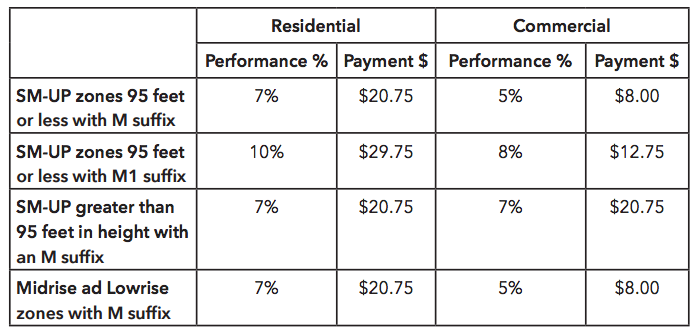
So in sum, this is the zoning and urban design proposal offered by OPCD. Since it is a draft, there is likely to be some minor changes made to it before a final version reaches the City Council later this year.
Draft Ordinance for Development Regulations Related to the Uptown Rezone by The Urbanist on Scribd
Stephen is a professional urban planner in Puget Sound with a passion for sustainable, livable, and diverse cities. He is especially interested in how policies, regulations, and programs can promote positive outcomes for communities. With stints in great cities like Bellingham and Cork, Stephen currently lives in Seattle. He primarily covers land use and transportation issues and has been with The Urbanist since 2014.

